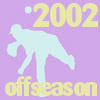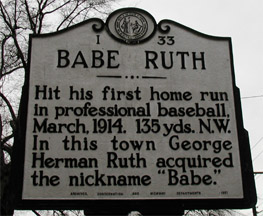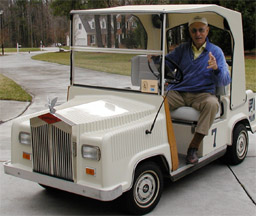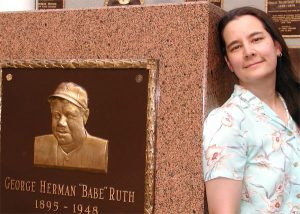I just heard the news that Tommy “The Wild Man” Byrne passed away. I visited him in March of 2003 and spent a couple of hours at his home talking baseball and in particular recapping that hreatbreaking Game Seven he pitched against Johnny Podres in the World Series. Since Phil Rizzuto died, I’ve been thinking Tommy might go next. Thank goodness Yogi is still going strong.
Since I’m just now re-launching Why I Like baseball under a new URL, I figured I’d remember Tommy by reprinting here the recap of the day we met. He’ll be missed.
Reprinted from: March 6, 2003
 When I arrived at Boston’s Logan airport this morning, the roads were crackling with fresh ice and the forecast was for snow. When I stepped onto the tarmac three hours later at Raleigh-Durham International Airport, the air was moist with balmy rain. Folks here tell me it’s unusually cold for this time of year, but you won’t hear me complaining. Suddenly, my brain is thawed and I can think about baseball again. I am here in North Carolina to begin a drive through the the south in search of baseball landmarks.
When I arrived at Boston’s Logan airport this morning, the roads were crackling with fresh ice and the forecast was for snow. When I stepped onto the tarmac three hours later at Raleigh-Durham International Airport, the air was moist with balmy rain. Folks here tell me it’s unusually cold for this time of year, but you won’t hear me complaining. Suddenly, my brain is thawed and I can think about baseball again. I am here in North Carolina to begin a drive through the the south in search of baseball landmarks.
Ostensibly I am here as research for a novel I am writing, one where the characters will be trekking south in search of a way to reverse the Curse of the Bambino. But as I inhale the humid, lazy breeze I realize that maybe what I am really in search of heart’s ease. Not to go into gory detail on my personal life or state of mind, but this winter has been cold and long.
This has nothing to do with baseball, or does it? I flew to Carolina in the smallest plane I have ever been in. It seated thirty people and the plane was full of men, businessmen mostly, mover and shaker types, from their mid-thirties to their mid-sixties. Them, and me. In that way it was not unlike being in a major league press box. Story of my life, I guess, to be one of the only women in a man’s world. No one seems to mind.
One of the themes of my novel, and indeed one of the recurring motifs in baseball history, is that strange coincidences occur. Here’s the first one of the trip: the rental car they gave me has New York plates on it.
My first stop was Fayetteville, NC. In 1914, Babe Ruth was signed by the minor league Baltimore Orioles straight out of St. Mary’s Industrial School, from the arms of Brother Mathias to Jack Dunn. Dunn had a friend who owned a hotel in Fayetteville and who said he’d put the team up for free if Dunn wanted to bring them down for spring training. The young Ruth, entirely naive about the world, rode on a train for the first time and learned, to his delight, that he was allowed to eat as much as he wanted on Dunn’s dime. His first appearance as a professional player came in an intra-squad game and the home run he hit into the cornfields was of note not only because homers were so rare in those days, but because back then they still thought of the big kid as a pitcher, not a hitter.
 The homer was hit at a field on government land, an old fairgrounds, which is now the site of some government buildings and the offices of the highway department. In 1951, just a few years after Ruth passed away, the son of the hotel owner lobbied to have a marker erected on the site. While driving through the historic section of Fayetteville you see quite a few of these historic markers, commemorating poets, soldiers, the sites of historic buildings, and so on. Ruth’s marker is located where it is easy to see from the road and seems to indicate that the actual spot being commemorated is “135 yards northwest”–beyond an impassable chain link fence as far as I could tell.
The homer was hit at a field on government land, an old fairgrounds, which is now the site of some government buildings and the offices of the highway department. In 1951, just a few years after Ruth passed away, the son of the hotel owner lobbied to have a marker erected on the site. While driving through the historic section of Fayetteville you see quite a few of these historic markers, commemorating poets, soldiers, the sites of historic buildings, and so on. Ruth’s marker is located where it is easy to see from the road and seems to indicate that the actual spot being commemorated is “135 yards northwest”–beyond an impassable chain link fence as far as I could tell.
Now you might be asking, why did I have to drive all the way to Fayetteville, North Carolina to see this marker, to see this historic place, if the place itself isn’t even there anymore? I already know the story of the homer–I know quite a lot more than one can tell from looking at a plaque. So, why go to see it? Right now I’m not sure I can articulate the answer to that question. It may be that if you have to ask the question, you wouldn’t understand the answer, anyway. To me, the answer seems self-evident, but not that easy to explain. I suppose one answer is this: the same thing that drives me to go to visit sites like this, drives other people to put up brass plaques and markers in the first place. It’s important.
From Fayetteville I headed to Wake Forest to meet Tommy Byrne. I spent the afternoon at his house talking baseball with him. When I originally contacted him, I was hoping to put together a feature on him for Yankees Magazine. I had no idea that he had a connection to Babe Ruth, but he does. Byrne was a wild lefthander in the late Dimaggio and early Mantle eras who several times led the league in hit batsmen. He also lost a heartbreaker of a game in 1955, Game Seven of the World Series against the Dodgers. The connection to Ruth dates back further than that, though. Byrne met Babe Ruth when he was only four years old, when he was living in an orphanage in Baltimore. I asked him if he wanted to be a ballplayer. “Every lefthanded kid in Baltimore wanted to be Babe Ruth,” he told me. “And I figured if he could do it, I could do it.” Late in his life, Ruth used to come to Yankee Stadium for Old Timers festivities. “He would always borrow my glove,” Byrne reminisced. “A ‘pud,’ he always called it a ‘pud.’ He’d say to Pete Sheehy the clubhouse man, ‘where is the Baltimore kid’s locker?’ I’d have let him have everything in the locker if he wanted. He could have borrowed a glove from Lopat, we had lots of lefthanders around. But he always asked for me, the Baltimore kid.”
We talked plenty about Dimaggio, Mantle, Don Larsen’s perfect game in ’56, the 1949 pennant race, and the importance of a good change of speed. I also had a gander at some of his memorabilia, including Mickey Mantle’s custom Rolls Royce style pinstriped #7 golf cart. Yes, golf cart. The thing has a built in cooler and stereo sound system. Tommy got it for $6500 in a charity auction and is thinking of donating it to the Hall of Fame in Cooperstown, if they have room for it. A memorabilia guy in the neighborhood figures it could be worth as much as $56,000. Wow.
 On my way out of Wake Forest I stopped at a nearby Appleby’s restaurant which had more of Tommy’s photos and memorabilia on display as tribute to their local hero. Tommy’s wife passed away just a few months ago and he isn’t feeling too good himself lately. “A lot of the old guys are running out of gas now,” he said, when we were talking about Ted Williams and Enos Slaughter (who also passed on recently.) “I’m going to run out of gas myself soon,” he said, “but I hate to give up my hobby.” What hobby? I asked. “Breathing,” he joked. One of the niftiest photos on the Appleby’s wall is an aerial view of Yankee Stadium, taken when Tommy was on the mound, if the caption is to be believed. The photo was taken over fifty years ago, and the Stadium has changed, but the Macombs Dam Bridge, the municipal ballfields, the elevated train line, are all the same as today. It makes it seem like maybe it wasn’t so long ago after all.
On my way out of Wake Forest I stopped at a nearby Appleby’s restaurant which had more of Tommy’s photos and memorabilia on display as tribute to their local hero. Tommy’s wife passed away just a few months ago and he isn’t feeling too good himself lately. “A lot of the old guys are running out of gas now,” he said, when we were talking about Ted Williams and Enos Slaughter (who also passed on recently.) “I’m going to run out of gas myself soon,” he said, “but I hate to give up my hobby.” What hobby? I asked. “Breathing,” he joked. One of the niftiest photos on the Appleby’s wall is an aerial view of Yankee Stadium, taken when Tommy was on the mound, if the caption is to be believed. The photo was taken over fifty years ago, and the Stadium has changed, but the Macombs Dam Bridge, the municipal ballfields, the elevated train line, are all the same as today. It makes it seem like maybe it wasn’t so long ago after all.
For dinner I made my way into Durham, to Bullock’s Barbecue, to meet local baseball writer/editor Chris Holaday for dinner. Bullock’s came onto my radar as a place that features photos of many famous celebrities on the walls, including photos of the game when the Yankees played the University of North Carolina in 1981 and the post-game party that the restaurant catered. Catfish Hunter, Yogi Berra, Bucky Dent, Tommy John, Graig Nettles, Reggie Jackson, and many more are in the photos. That alone would have made it worth the trip, but then there were the best hush puppies I have ever eaten. The pork barbecue, fried chicken, and Bismarck stew were also super-tasty, and a great way to cap off a very busy day.
End of reprint. The rest of the travels can be found at the Why I Like Baseball Archives, Here!


Post a Comment